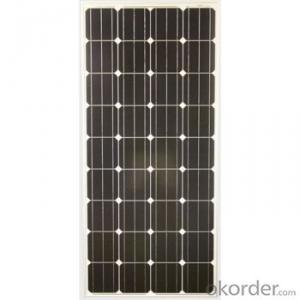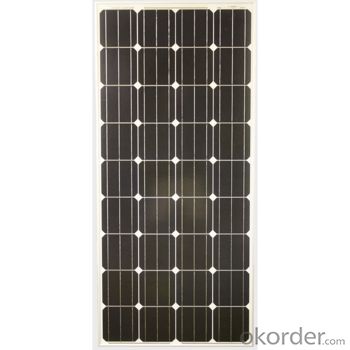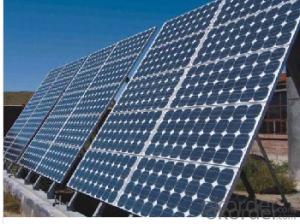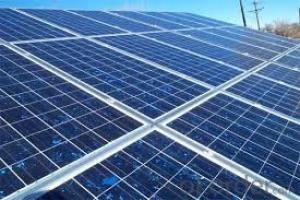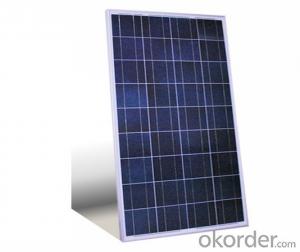40w Poly Solar Panel Small Solar Panel Factory Directly Sale CNBM - Solar Panels Southern California
- Loading Port:
- Qingdao
- Payment Terms:
- TT OR LC
- Min Order Qty:
- 10 set
- Supply Capability:
- 300000 set/month
OKorder Service Pledge
OKorder Financial Service
You Might Also Like
Polycrystalline Solar Modules
CNBM offers a range of small, medium and large polycrystalline solar modules, designed for a range of requirements.

Specifications:
Tolerance | +/-3% |
Cell | Polycrystalline silicon solar cells (156 x 156mm) |
N0. of Cells | 60 (10 x 6) |
Dimension of Modules (mm) | 1650 x 990 x 40 |
Weight (kg) | 25.5 |
Limits:
Operating Temperature | -40~+85? |
Storage Temperature | -40~+85? |
Maximum System Voltage | 1000 VDC max. |
Hail Impact | Diameter of 28mm with impact speed |
Temperature and Coefficients:
NOCT | 48C+/-2? |
Voltage temperature coefficient (%/K) | -0.35 |
Current temperature coefficient (%/K) | 0.05 |
Power temperature coefficient (%/K) | -0.45 |
Characteristics:
Model: | SGM-200P | SGM-210P | SGM-220P |
Max-power voltage Vmp (V) | 29.2 | 29.4 | 29.41 |
Max-power current Imp (A) | 6.85 | 7.14 | 7.48 |
Open-circuit voltage Voc (V) | 36.5 | 36.69 | 36.9 |
Short-Circuit Current Isc (A) | 7.28 | 7.6 | 7.93 |
Max-power Pm(W) | 200 | 210 | 220 |
Model: | SGM-230P |
Max-power voltage Vmp (V) | 29.8 |
Max-power current Imp (A) | 7.72 |
Open-circuit voltage Voc (V) | 37.31 |
Short-Circuit Current Isc (A) | 8.19 |
Max-power Pm(W) | 230 |
STC: Irradiance 1000W/m2, module temperature 25?, AM-=1.5
Poly Crystalline Solar Panels Specifications Range
Maximum Power (Pm) | Dimension | Weight | Operating Voltage (Vmp) | Operating Current (Imp) | Open Circuit Voltage (Voc) | Short Circuit Current (Isc) |
0.45W | 140x80x10mm | 0.08kg | 3.3V | 150mA | 4.6V | 160mA |
1.0W | 162x140x10mm | 0.16kg | 7.5V | 150mA | 10.3V | 160mA |
4.5W | 269x251x23mm | 0.8kg | 16.5V | 0.27A | 20.5V | 0.3A |
10W | 420.1×268.9×22.6mm | 1.92kg | 17.5V | 0.58A | 20.5V | 0.6A |
20W | 425x502x50mm | 3.0kg | 16.8V | 1.19A | 21.0V | 1.29A |
30W | 593x502x22.6mm | 3.9kg | 16.8V | 1.78A | 21.0V | 1.94A |
40W | 655x537x50mm | 5.75kg | 17.3V | 2.31A | 22.1V | 2.54A |
50W | 839x537x50mm | 6.0kg | 17.5V | 2.9A | 21.8V | 3.17A |
65W | 1111x502x50mm | 7.2kg | 17.6V | 3.69A | 22.1V | 3.99A |
80W | 1204x537x50mm | 7.7kg | 17.6V | 4.55A | 22.1V | 4.8A |
- Q: Can solar panels be used for charging electric bicycles?
- Yes, solar panels can be used for charging electric bicycles. By connecting the solar panels to a charge controller and then to the electric bicycle's battery, the energy from the sun can be converted into electrical energy to charge the bike's battery. This allows for a sustainable and renewable way of charging electric bicycles.
- Q: Can solar panels be used in areas with high pollution levels?
- Yes, solar panels can be used in areas with high pollution levels. While pollution can potentially decrease the efficiency of solar panels, they can still generate electricity even in polluted environments. Additionally, using solar energy can help in reducing reliance on polluting fossil fuels, contributing to the overall improvement of air quality.
- Q: what parts and tool do i need to build and connect a solar electric panel to my home
- Dear Matadora, Very good, good, good step to change your home electric supply to solar cell, because in long run, solar cell is cheaper. First you have to consider Power need for your house, eg. 200W, then you go to sellers and choose one with lowest price but best quality. After that you should assemble/attach your solar panel in place that gets most Sunlight, most probably in your roof. Attach them tightly, avoid burglar. Original solar cell current is DC. Current from solar cell placed first in several car batteries, so you could use electricity in night either. After that if your home appliances use DC, you could directly connect your appliances to batteries. But if your appliances need AC, current should be converted first from DC to AC use DC to AC converter. Car battery used to have 2 Volt DC. So if you need 220VAC, after DC converted into AC, then passed through transformer to increase voltage. Thank you very much Matadora.
- Q: Do solar panels work with any type of heat or only sunlight? I have a bunch of little ideas floating around in my head and Id like to get them on paper but only if they really would work.Also does a concentrated amount of heat on one solar panel piece (quot;xor so) produce a higher or equal amount of electricity than a less concentration over a larger area?
- Solar photovoltaics require light, any kind of light. A torch would work, for example. The effect of concentration depends on the amount of light and the material you're shining it on. In CdTe, warmer temperatures and more intense light may lead to better performance. In silicon I think the opposite is true (I don't know though, I've only done research work with CdTe). It depends on properties of the semiconductor, like its band structure. To get an 'order of magnitude' estimate, you may assume a constant efficiency of solar cell so total amount of light (= area * intensity) largely determines the output in standard operating conditions.
- Q: What is the lifespan of solar panel batteries?
- The lifespan of solar panel batteries can vary depending on various factors such as their quality, usage patterns, and maintenance. On average, well-maintained solar panel batteries can last anywhere between 5 to 15 years. However, advancements in technology and improvements in battery design are constantly being made, which could potentially extend their lifespan in the future.
- Q: I don't know anything about solar and what connections that have to be made. any advice and wisdom would be appreciated. thanks
- The okorder ) or the Tekkeon 3450 with the optional MagSafe connector (or the same Apple Airline cable as described for the Brunton). Set the output voltage to 9V and use the 2V cigarette socket outlet, and plug the airline adaptor cable in. Can you simply use an AC inverter? Not direct from the solar panel... a solar panel is not able to drive an inverter. But you could plug an AC inverter into a solar storage battery pack if it is designed to support inverters. BUT, an inverter will waste 20-30% of your power in the conversion to AC which your laptop will be converting back to DC anyway, so best to stick to DC and save your solar investment from the losses. Summary... 0 Watts of solar per hour of laptop use (May-Sep) 50 Watt-Hours of solar battery storage per hour of laptop use Use a solar battery pack with appropriate output voltages built-in, and avoid AC inverters. This is probably a longer answer than you were expecting, but knowledge is power. Cheers.
- Q: Can solar panels be used to power swimming pools?
- Yes, solar panels can indeed be used to power swimming pools. Solar panels can generate electricity from sunlight, which can be used to operate pool pumps, heaters, and other equipment, reducing the reliance on traditional electricity sources and saving on energy costs.
- Q: What is the most efficient solar panel, how many would we need to power the United States, and how much land would it take?
- Annual power consumption in the US is approximately .2*0^5 Watt-hours. The average solar panel can generate 80W continuously. We can break up the calculation into parts: .2*0^5 Watt-hours per year 925 hours per year .3*0^ continuous watts 80W per panel 64383566 panels 000 sq. inches average solar panel area 650 million square miles (!!!) To give you a better idea, the total surfacre area of the United States of America is 3 million square miles. The surface of the earth is 96 million square miles. Not even 3 planets full of solar panels would be enough. Maybe it is easier for people to start using electricity more responsibly?
- Q: Basically I need a custom solar panel created. I won't go into detail but the dimensions need to be around 4''x2.5'' and be as thin as possible.
- okorder Other sources available on the first Link also. Wingman
- Q: planning to get one, for a store/house, we use alot of electricity at least 500-3000 dollars a month. how much money would this save us? how big would we have to get the solar panel?[aproximately]
- Hi, One or two new windmills may not cost you as much I believe. Just my suggestion anyway.
Send your message to us
40w Poly Solar Panel Small Solar Panel Factory Directly Sale CNBM - Solar Panels Southern California
- Loading Port:
- Qingdao
- Payment Terms:
- TT OR LC
- Min Order Qty:
- 10 set
- Supply Capability:
- 300000 set/month
OKorder Service Pledge
OKorder Financial Service
Similar products
Hot products
Hot Searches
Related keywords
